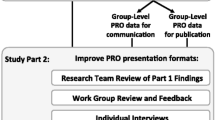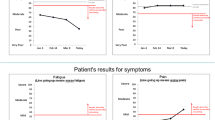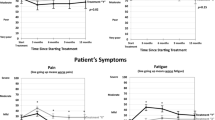Abstract
Background
Patient-reported outcomes (PROs) promote patient-centered care by using PRO research results (“group-level data”) to inform decision making and by monitoring individual patient’s PROs (“individual-level data”) to inform care. We investigated the interpretability of current PRO data presentation formats.
Method
This cross-sectional mixed-methods study randomized purposively sampled cancer patients and clinicians to evaluate six group-data or four individual-data formats. A self-directed exercise assessed participants’ interpretation accuracy and ratings of ease-of-understanding and usefulness (0 = least to 10 = most) of each format. Semi-structured qualitative interviews explored helpful and confusing format attributes.
Results
We reached thematic saturation with 50 patients (44 % < college graduate) and 20 clinicians. For group-level data, patients rated simple line graphs highest for ease-of-understanding and usefulness (median 8.0; 33 % selected for easiest to understand/most useful) and clinicians rated simple line graphs highest for ease-of-understanding and usefulness (median 9.0, 8.5) but most often selected line graphs with confidence limits or norms (30 % for each format for easiest to understand/most useful). Qualitative results support that clinicians value confidence intervals, norms, and p values, but patients find them confusing. For individual-level data, both patients and clinicians rated line graphs highest for ease-of-understanding (median 8.0 patients, 8.5 clinicians) and usefulness (median 8.0, 9.0) and selected them as easiest to understand (50, 70 %) and most useful (62, 80 %). The qualitative interviews supported highlighting scores requiring clinical attention and providing reference values.
Conclusions
This study has identified preferences and opportunities for improving on current formats for PRO presentation and will inform development of best practices for PRO presentation. Both patients and clinicians prefer line graphs across group-level data and individual-level data formats, but clinicians prefer greater detail (e.g., statistical details) for group-level data.



Similar content being viewed by others

References
U.S. Food and Drug Administration. (2009). Guidance for industry. Patient reported outcome measures: Use in medical product development to support labelling claims. Federal Register, 74, 65132–65133.
Acquadro, C., Berzon, R., Dubois, D., et al. (2003). Incorporating the patient’s perspective into drug development and communication: An ad hoc task force report of the patient-reported outcomes (PRO) harmonization group meeting at the food and drug administration, February 16, 2001. Value in Health, 6, 522–531.
Lipscomb, J., Gotay, C., & Snyder, C. (2005). Outcomes assessment in cancer: Measures, methods, and applications. Cambridge: Cambridge University Press.
Bruner, D. W., Bryan, C. J., Aaronson, N., et al. (2007). Issues and challenges with integrating patient-reported outcomes in clinical trials supported by the National Cancer Institute–sponsored clinical trials networks. Journal of Clinical Oncology, 25, 5051–5057.
Till, J. E., Osoba, D., Pater, J. L., et al. (1994). Research on health-related quality of life: Dissemination into practical applications. Quality of Life Research, 3, 279–283.
Au, H.-J., Ringash, J., Brundage, M., et al. (2010). Added value of health-related quality of life measurement in cancer clinical trials: The experience of the NCIC CTG. Expert Review of Pharmacoeconomics and Outcomes Research, 10(2), 119–128.
Bezjak, A., Ng, P., Skeel, R., et al. (2001). Oncologists’ use of quality of life information: Results of a survey of eastern cooperative oncology group physicians. Quality of Life Research, 10(1), 1–13.
Brundage, M., Bass, B., Jolie, R, et al. (2011). A knowledge translation challenge: Clinical use of quality of life data from cancer clinical trials. Quality of Life Research, 20(7), 979–985.
Brundage MD, Feldman-Stewart D, Bezjak A, et al. (2005). The value of quality of life information in a cancer treatment decision. ISOQOL 11th annual conference, San Francisco.
Snyder, C. F., & Aaronson, N. K. (2009). Use of patient-reported outcomes in clinical practice. Lancet, 374, 369–370.
Greenhalgh, J. (2009). The applications of PROs in clinical practice: What are they, do they work, and why? Quality of Life Research, 18, 115–123.
Velikova, G., Booth, L., Smith, A. B., et al. (2004). Measuring quality of life in routine oncology practice improves communication and patient well-being: A randomized controlled trial. Journal of Clinical Oncology, 22, 714–724.
Santana, M. J., Feeny, D., Johnson, J. A., et al. (2010). Assessing the use of health-related quality of life measures in the routine clinical care of lung-transplant patients. Quality of Life Research, 19, 371–379.
Detmar, S. B., Muller, M. J., Schornagel, J. H., et al. (2002). Health related quality of life assessments and patient physician communication. Journal of the American Medical Association, 288, 3027–3034.
Berry, D. L., Blumenstein, B. A., Halpenny, B., et al. (2011). Enhancing patient-provider communication with the electronic self-report assessment for cancer: A randomized trial. Journal of Clinical Oncology, 29, 1029–1035.
PROQOLID (2012). The patient-reported outcome and quality of life instruments database. http://www.proquolid.org.
Snyder, C. F., Jensen, R., Courtin, S. O., et al. (2009). Patientviewpoint: A website for patient-reported outcomes assessment. Quality of Life Research, 18(7), 793–800.
Jones, J. B., Snyder, C. F., & Wu, A. W. (2007). Issues in the design of internet-based systems for collecting patient-reported outcomes. Quality of Life Research, 16, 1407–1417.
Snyder, C. F., Blackford, A. L., Wolff, A. C., et al. (2013). Feasibility and value of Patientviewpoint: A web system for patient-reported outcomes assessment in clinical practice. Psycho-Oncology, 22, 895–901.
Brundage, M., Feldman-Stewart, D., Leis, A., et al. (2005). Communicating quality of life information to cancer patients: A study of six presentation formats. Journal of Clinical Oncology, 23, 6949–6956.
McNair, A. G., Brookes, S. T., Davis, C. R., et al. (2010). Communicating the results of randomized clinical trials: Do patients understand multidimensional patient-reported outcomes? Journal of Clinical Oncology, 28, 738–743.
Aaronson, N. K., Ahmedzai, S., Bergman, B., et al. (1993). The european organization for research and treatment of cancer QLQ-C30: A quality-of-life instrument for use in international clinical trials in oncology. Journal of the National Cancer Institute, 85, 365–376.
Abernethy, A. P., Wheeler, J. L., & Zafar, S. Y. (2010). Management of gastrointestinal symptoms in advanced cancer patients: The rapid learning cancer clinic model. Current Opinion in Supportive and Palliative Care, 4, 36–45.
PROMIS Software Demonstration (2012). http://nihpromis.org/software/demonstration.
Creswell, J. W. (2007). Qualitative inquiry and research design: Choosing among five approaches (2nd ed.). Thousand Oaks: Sage Publications.
Pope, C., Ziebland, S., & Mays, N. (1999). Analysing qualitative data. In C. Pope & N. Mays (Eds.), Qualitative research in health care (2nd ed., pp. 75–88). London: BMJ Publishing Group.
(2014). AtlasTi, in, ATLAS.ti Scientific Software Development GmbH.
Acknowledgments
This analysis was (partially) supported by a Patient-Centered Outcomes Research Institute (PCORI) Award (R-1410-24904). All statements in this report, including its findings and conclusions, are solely those of the authors and do not necessarily represent the views of the Patient-Centered Outcomes Research Institute (PCORI), its Board of Governors or Methodology Committee. Drs. Snyder and Smith are members of the Sidney Kimmel Comprehensive Cancer Center at Johns Hopkins (NCI P30 CA 006973). The funding sources had no role in study design, data collection, analysis, interpretation, writing, or decision to submit the manuscript for publication. The PRO Data Presentation Stakeholder Advisory Board includes Neil K. Aaronson, PhD (Netherlands Cancer Institute); Patricia A. Ganz, MD (University of California-Los Angeles and Jonsson Comprehensive Cancer Center); Ravin Garg, MD (Anne Arundel Medical Center); Michael Fisch, MD (M.D. Anderson Cancer Center); Bryce B. Reeve, PhD (University of North Carolina at Chapel Hill and Lineberger Comprehensive Cancer Center); Marc Silver (author of Breast Cancer Husband—How to Help Your Wife (and Yourself) Through Diagnosis, Treatment, and Beyond); Eden Stotsky-Himelfarb (Sidney Kimmel Comprehensive Cancer Center at Johns Hopkins); Ellen Stovall (National Coalition for Cancer Survivorship); Matthew Zachary (Stupid Cancer). The Johns Hopkins Clinical Research Network (JHCRN) site investigators and staff include: Ravin Garg, MD, and Steven P. DeMartino, CCRC, CRT, RPFT (Anne Arundel Medical Center), Melissa Gerstenhaber, MAS, MSN, RN, CCRN (JHCRN/Anne Arundel Medical Center); Gary Cohen, MD, and Cynthia MacInnis, BS, CCRP (Greater Baltimore Medical Center); James Zabora, ScD, MSW (Inova Health System), and Sandra Schaefer, BSN, RN, OCN (JHCRN/Inova Health System); Paul Zorsky, MD, Lynne Armiger, MSN, CRNP, ANP-C, Sandra L. Heineken, BS, RN, OCN, and Nancy J. Mayonado, MS (Peninsula Regional Medical Center); Michael Carducci, MD (Johns Hopkins Sibley Memorial Hospital); Carolyn Hendricks, MD, Melissa Hyman, RN, BSN, OCN, and Barbara Squiller, MSN, MPH, CRNP (Suburban Hospital). Finally, we are most grateful to the patients and clinicians who participated in this study.
Conflict of interest
The authors report no conflict of interest.
Author information
Authors and Affiliations
Consortia
Corresponding author
Rights and permissions
About this article
Cite this article
Brundage, M.D., Smith, K.C., Little, E.A. et al. Communicating patient-reported outcome scores using graphic formats: results from a mixed-methods evaluation. Qual Life Res 24, 2457–2472 (2015). https://doi.org/10.1007/s11136-015-0974-y
Accepted:
Published:
Issue Date:
DOI: https://doi.org/10.1007/s11136-015-0974-y



